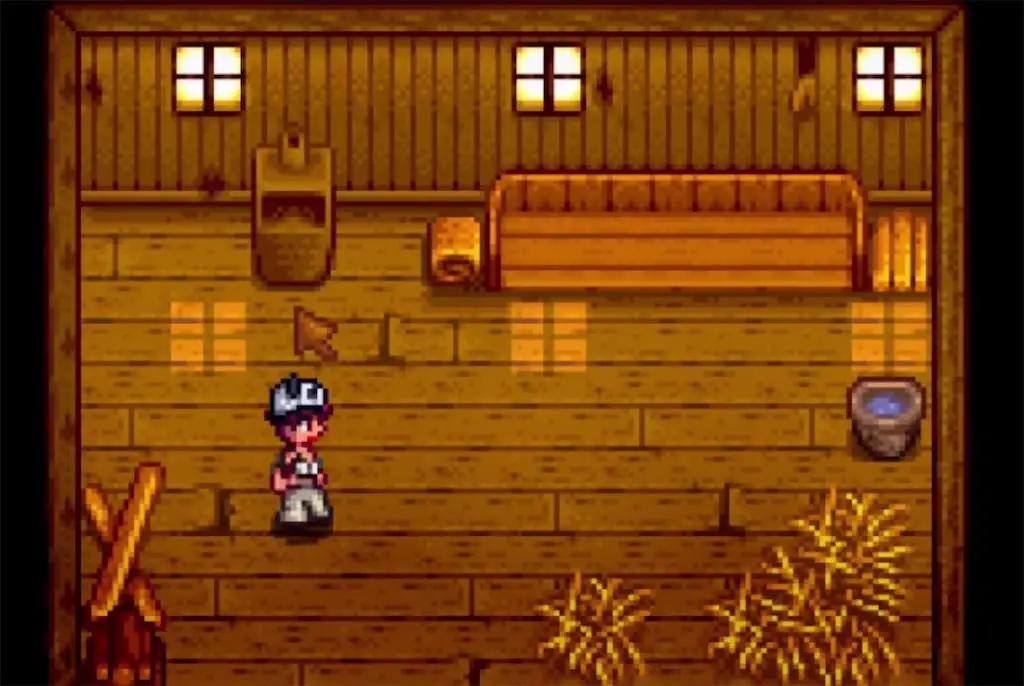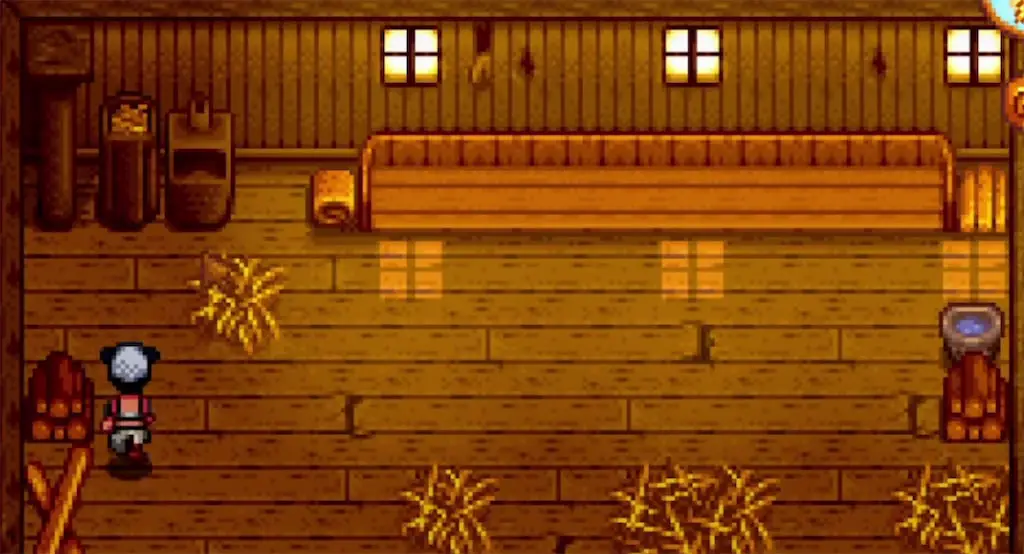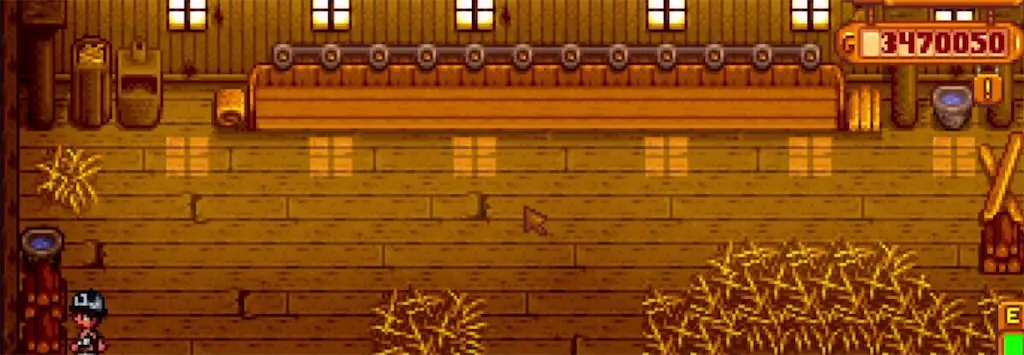Ultimate Stardew Valley Barn and Coop Animal Guide
In this tutorial, we’ll be discussing some basic information about raising animals in Stardew Valley. If you’re interested, let’s dive in together.
Types of Buildings
First, there are two types of buildings for animal husbandry: the Coop and the Barn, both of which can be built by visiting Robin. I will explain more about the corresponding animals and buildings later.

Basic Knowledge
Now let’s cover some basic knowledge about raising animals. There are three ways to feed animals:
- Purchase hay from Marnie and place it in the feeding troughs of the Coop or Barn

- Build a Silo, harvest hay using a scythe, and then take it out from the feed hoppers in the Coop or Barn with a right-click, placing it in the feeding troughs

- Let animals graze on the grass in the farm

To prevent animals from eating all the grass, you can use fences to contain the grass. This allows the grass to spread continuously.
Friendship and Mood Values
Next, let’s discuss animals’ friendship and mood values, which determine the quality of the products they produce. Animals living in the Barn or Coop have a friendship level that can be viewed by right-clicking after petting them. Friendship levels are divided into five stars, increasing in half-star increments. Each half-heart equals 100 friendship points, with a maximum limit of 1000 points. You can increase friendship by petting, milking, shearing, or allowing animals to eat grass on the farm. Correspondingly, not feeding, not petting, or leaving animals outside overnight will reduce friendship points. Keep in mind that animals left outside have a chance of being attacked by wild animals, causing them to disappear.

Mood value, like friendship, is an important factor affecting the quality and type of animal products. The current mood of an animal can be checked by right-clicking after petting them. Mood values are divided into three categories: very happy, in a good mood, and sad. In addition to feeding and petting, letting animals roam outside, eat grass, and providing heaters in winter will increase their mood. Conversely, not feeding, not petting, or leaving animals outside after 7 pm or during winter or rainy days will decrease their mood. It’s still unclear what conditions lead to animals being stuck outside, but it’s likely due to the player not leaving the farm after 5 pm (when animals return to the Barn or Coop) or not entering the Barn or Coop after 5 pm. Sleeping before 5 pm may also cause this issue.
To avoid problems, check out the tips below. If you’re focusing on animal husbandry, maximize animals’ mood values during non-winter seasons by petting them before letting them graze and closing the door after 6 pm each day. This prevents animals from going outside to eat grass before you can pet them the next day.
(One possible reason for animals getting stuck outside is that the player might not have left the farm after 5pm (when animals start to return to the barn/coop) or didn’t enter the barn/coop after 5pm. It seems that leaving the farm or entering the barn/coop after 5pm can help animals automatically return to their barn or coop and produce items. If the player goes to bed before 5pm, this situation might also occur.)
Animals and Products
Finally, let’s discuss specific animals and their products. For Coop animals, there are chickens, ducks, rabbits, and dinosaurs.

The basic Coop can only house chickens, featuring feeding troughs and a feed hopper. After upgrading to a Big Coop, you can raise ducks and dinosaurs and unlock the Incubator, which can be used to hatch chicken, duck, and dinosaur eggs. Upgrading to a Deluxe Coop allows you to raise rabbits and unlocks the auto-feeding system.



If there is hay in the Silo, it will automatically be placed in the feeding troughs to feed the animals.

Chickens, the first animals you’ll likely raise, come in white, brown, blue, black, and gold colors.
Blue chickens can be obtained after triggering Shane’s eight-heart event.

Black chickens, or Void Chickens, can be purchased at the Pig Cart or in the Sewer’s Krobus shop, or they may be left behind by a witch flying over during a random sleep event.

As for Golden Eggs, they can be purchased from Mr. Qi’s Walnut House on Ginger Island after reaching 100% perfection, using 100 Qi Gems.
Well-fed chickens will mature in three days after hatching or purchasing. From the fourth day onwards, adult chickens that were fed the previous day will each produce an egg every morning, and when they reach enough friendship and mood values, they will produce large eggs.

As for ducks, when well-fed, they mature within five days and lay an egg every other day. When certain conditions of friendship and mood values are met, and luck is sufficient, ducks will produce duck feathers. Note that food and ring luck bonuses do not affect duck feather production.

Rabbits, when well-fed, mature on the sixth day, and then produce animal wool every four days without needing to be sheared. When rabbits have high enough friendship and mood values, and the daily luck value is sufficient, rabbit’s feet may drop. Additionally, rabbit’s feet can be purchased at the Pig Cart or have a small chance of dropping after killing Serpents in the Skull Cavern.
Rabbit’s feet also have another use: they can unlock Secret Note #20. By talking to the truck driver next to the Joja Mart and giving him a rabbit’s foot, a special charm can be exchanged, which permanently increases luck.


As for dinosaurs, they need to be hatched from dinosaur eggs, which take about 12.5 days to hatch into a Dinosaur. Afterward, the Dinosaur will produce a dinosaur egg every seven days. Dinosaur eggs can be obtained by digging up worms, fishing treasure chests, scavenging in the desert mine’s prehistoric floors, or defeating pepper rexes. As obtaining dinosaur eggs is difficult, it’s best to put the first one directly into an incubator rather than donating it to the museum. Once the Dinosaur starts laying eggs, we can then donate one.

Barn Animals

Next, let’s talk about barn animals, which include cows, goats, sheep, pigs, and ostriches. The basic barn can only house cows, while the upgraded Big Barn can house goats and allows animals to become pregnant and give birth. The Deluxe Barn can house sheep and pigs and unlocks the auto-feeding system. As this is similar to the coop, we won’t discuss it further. Lastly, ostriches can be housed in the basic barn, but most players will have a Big Barn by that point.


Cows come in two colors, white and brown, but they all produce milk. Well-fed cows take five days to mature, and as long as their mood value is high enough, they will produce milk daily. Milk can be obtained using a milk pail, which is purchased from Marnie. When friendship values are high enough, cows will produce Large Milk.

Goats, like cows, take five days to mature, but they produce goat milk every other day when their mood value is high enough.

Sheep take four days to mature, and when their wool has grown, it can be sheared using shears purchased from Marnie. Typically, wool can be sheared every three days, and high friendship value sheep grow wool faster. If you have the Shepherd skill, wool growth time is reduced by one day.

Pigs are a profitable animal to raise, and new players are generally recommended to raise pigs. Pigs take ten days to mature, and unlike other animals, adult pigs do not produce items inside the barn but instead forage for truffles outside. When pigs are let out of the barn, each tile has a chance of producing a truffle, so the truffles produced each day will be randomly distributed on the ground where the pigs have walked.
However, it should be noted that truffles cannot be produced on tiles covered with flooring or debris. To ensure that pigs can produce truffles, try to keep most of the paths they walk on uncovered. To produce truffles, pigs must be well-fed, it must not be winter, and there should be no rain. When the conditions are met, let the pigs out of the barn to forage for truffles.
If truffles are not picked up, they will not disappear the next day but will vanish at the beginning of the next season. Therefore, if you want to collect truffles at once, you need to consider the plot and timing. Generally, if you are not exclusively raising pigs, it is recommended to start raising pigs in the middle of the first winter, so you can collect truffles at the beginning of the second year. This way, pigs won’t eat your food all winter without producing anything.

Lastly, ostriches are more of a late-game animal. They require an Ostrich Incubator to hatch Ostrich Eggs, which is obtained after completing donations at the Island Museum on Ginger Island. Ostrich eggs can be found through Island Journal Scrap #10 or randomly dropped in chests in the Volcano Dungeon.

Conclusion
That concludes this tutorial. One more thing to add: the Auto-Petter can be purchased for 50,000 gold at the Joja Mart after completing the Joja Warehouse or found in treasure chests in the Skull Cavern. When placed inside a barn or coop, the Auto-Petter saves time petting animals.